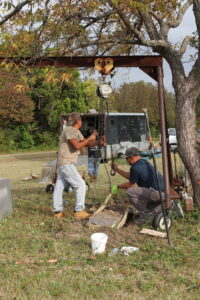Preservation and Maintenance
Conservation of Cemetery Structures
Prior to cleaning or maintaining any element, written and photographic documentation of the existing condition should be made. Cleaning and maintenance must follow the Secretary of the Interior’s Standards for Preservation, specifically Preservation Brief 48 (NPS 2016). New damages that have occurred since the last maintenance should be noted. This documentation should occur with every cleaning and be stored in a central location.
Cemetery Maintenance
Regular maintenance of a cemetery is the most important aspect of cemetery preservation, as routine maintenance prevents future problems that are often destructive to cemetery structures and expensive, if not impossible, to remedy. In addition, certain maintenance procedures must be undertaken carefully so as not to damage such structures.
Don’t
- Use lawnmowers directly around headstones.
- Use herbicides or fertilizers on the surrounding vegetation as these can be absorbed by headstones and cause premature deterioration.
- Plant trees on or near headstones because as the tree grows, it can eventually encroach upon and topple headstones.
- Lean fallen headstones against standing ones as the weight might cause the standing stone to fall. It is best to leave a headstone where it is on the ground.
- Move headstones or headstone fragments from their original locations.
- Reset stones by embedding them directly into concrete.
- Reconstruct gravestones using metal splints or braces or embedding face up in concrete. Not only is this unattractive and detracts from the stone’s historical integrity, it can be further detrimental to the stone because they cannot bear the weight of the splints or braces over time, and the tablet-style stones placed face up will collect moisture more rapidly. This constant soaking and drying effect can cause premature cracking, spalling, and erosion. Laying the stone on the ground also puts it in greater danger of lawnmower damage.
- Attempt to seal or waterproof a headstone because it can lock in moisture already absorbed by the stone and result in premature deterioration.
- Clean headstones with high powered hoses, wire or other stiff bristled brushes, metal objects, bleach, or detergents.
Do:
- Use a nylon whip grass-cutter (“weed eater”) around headstones to prevent damage to them.
- Monitor and regularly prune trees that are present in a cemetery to prevent fallen limbs from damaging cemetery structures. Dead or dying trees should be removed for the same reason, and trees that are encroaching upon cemetery structures should be removed.
- Record the exact location of headstones or headstone fragments if they must be moved temporarily.
- Have leaning, fallen, or broken cemetery structures repaired and reset as quickly as possible to prevent additional damage to the stones. A qualified professional should be hired to reset stones.
- Ask for references and examples of previous work when hiring a restoration professional.
- Use only approved methods for headstone cleaning, resetting, and repair (see Preservation Brief 48 [NPS 2016]).
Creating and Maintaining a Respectful Location
 As part of the preservation criteria, the property owner should strive to create and maintain a respectful location for the people interred in McCree Cemetery. The crux of this approach is systematic maintenance. The maintenance will include the following:
As part of the preservation criteria, the property owner should strive to create and maintain a respectful location for the people interred in McCree Cemetery. The crux of this approach is systematic maintenance. The maintenance will include the following:
- Grounds Cleaning: Perform routine grounds cleaning so that they are free of paper, trash, bottles, and other discarded material.
- Grass Trimming: Trim grass at regular intervals during the year such that the wild grass does not exceed a height of 3 to 6 inches with a nylon whip grass-cutter with a “bumper” guard (“weed eater”). Grass cuttings shall not be left in random piles or other unsightly conditions. Care should be taken to not cut any flowers that may be blooming on or next to a grave as these may be ornamental and protected by state law.
- Grass Edging: Grass adjacent to fences and headstones shall be trimmed and present a neat appearance. A nylon whip grass-cutter with a “bumper” guard (“weed eater”) shall be used around headstones to prevent damage. Grass shall be trimmed so as to maintain a growth free area between 1 and 1.5 inches away from obstacles such as fence and headstones.
- Vegetation Trimming: Annually prune non-ornamental shrubs and trees that are present in the cemetery or overhang above the cemetery to prevent fallen limbs from damaging cemetery structures (e.g., fence and headstones). Dead or dying trees should be removed for the same reason, and trees that are encroaching upon cemetery structures should be removed. No ornamental shrubs were identified during the archeological survey; thus, all shrubs can be trimmed or removed.
- Vegetation Planting: No new shrubs or trees may be planted on a grave. No new destructive or invasive ground cover, such as Boston Ivy or Asian Jasmine, may be planted.